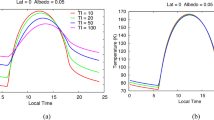Abstract
The desire to measure atmospheric emission spectra of the upper atmosphere has led to the development of cryogenically cooled infrared Fourier transform spectrometers. These spectrometers combine the sensitivity advantage of a Fourier transform spectrometer with the sensitivity gains obtainable with modern infrared detectors operated at low photon backgrounds. The temperature required to obtain maximum sensitivity is primarily determined by the wavelength region of interest, longer wavelengths requiring lower temperatures. In order to take full advantage of reduced background operation, the preamplifier must be cooled in order to reduce the noise. Low noise preamplifiers capable of operation down to liquid helium temperatures have been developed. Three cryogenically cooled spectrometers of significantly different design are discussed. The first instrument is a standard Michelson interferometer cooled to 10 K with supercritical helium and capable of 1 wave number resolution. This interferometer has been successfully flown on a rocket and obtained measurements of atmospheric limb emission at tangent altitudes from 70 km to 150 km. The second is a field widened prism interferometer which operates at liquid nitrogen temperature and has been flown on a rocket and obtained measurements of atmospheric emission in the 2 to 8 micrometer region during an aurora. The third is a balloon borne liquid nitrogen cooled interferometer which incorporates cat's eye retroreflectors for end mirrors and is capable of 0.1 wave number resolution. This spectrometer has successfully flown on a balloon several times and obtained measurements of atmospheric limb emission at tangent altitudes from 0 km to 30 km.
Similar content being viewed by others
References
C. L. Wyatt,Radiometric System Design, Macmillan, New York, 1987, p. 263.
J. C. Kemp, R. J. Huppi,SPIE 1979,191, 135.
J. C. Kemp, R. J. Huppi,SPIE 1980,245, 34.
R. H. Haycock,A Cryogenically Cooled Field Widened Interferometer for Rocketborne Near Infrared Atmospheric Studies, SDL/83-029, Utah State University, 1983.
G. A. Vanasse,Stratospheric Cryogenic Interferometer Balloon Experiment, AFGL-TR-81-0048, Hanscom AFB, Massachusetts, 1981.
H. L. Buijs, D. Laporte,SPIE 1980,245, 48.
J. P. Dybwad, R. J. Huppi, R. E. McKenna, D. P. Saletnic, B. J. Thomas, V. Griffiths,SPIE 1987,787, 114.
J. C. Kemp, S. J. Wellard, D. C. Goode, E. R. Huppi,SPIE 1986,686, 151.
V. G. Kunde, J. C. Brasunas, B. J. Conrath, R. A. Hanel, J. R. Herman, D. E. Jennings, W. C. Maguire, D. W. Walser, J. N. Annen, M. J. Silverstein, M. M. Abbas, L. W. Herath, H. L. Buijs, J. N. Berube, J. McKinnon,App. Opt. 1987,26, 545.
P. Bouchareine, P. Connes,J. Phys. Rad. 1963,24, 134.
H. Sakai, T. C. Li, W. Barowy, S. Pulchtopec, J. Pritchard, F. J. Murcray, F. H. Murcray, G. Vanasse,SPIE 1982,364, 38.
F. H. Murcray, F. J. Murcray, D. G. Murcray, J. Pritchard, G. Vanasse, H. Sakai,J. Atm. Oceanic Tech. 1984,1, 351.
J. Connes, P. Connes,J. Opt. Soc. Am. 1966,56, 896.
Author information
Authors and Affiliations
Rights and permissions
About this article
Cite this article
Huppi, E.R. Cryogenic instrumentation and detector limits in FTS. Mikrochim Acta 93, 281–296 (1987). https://doi.org/10.1007/BF01201695
Received:
Issue Date:
DOI: https://doi.org/10.1007/BF01201695




